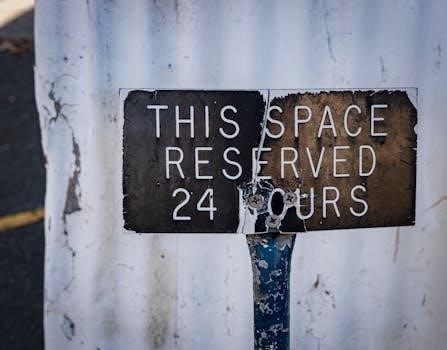
30-Day Notice to Vacate⁚ An Overview
A 30-day notice to vacate is a formal written communication used to inform a landlord or tenant of an upcoming lease termination. This document outlines the intent to vacate a rental property within a 30-day timeframe, ensuring compliance with lease agreements and legal requirements.

Understanding the 30-Day Notice Requirement
The 30-day notice to vacate serves as a crucial element in lease agreements, particularly for month-to-month tenancies. It provides a structured timeframe for both landlords and tenants to prepare for the transition, ensuring legal and contractual obligations are met by both parties.
Purpose of a 30-Day Notice
The primary purpose of a 30-day notice is to provide formal notification of intent to terminate a lease agreement. This ensures both landlords and tenants have adequate time to prepare for the transition, whether it involves finding a new tenant or securing a new residence. For landlords, it allows time to advertise the property, screen potential renters, and minimize vacancy periods.
For tenants, the notice period offers an opportunity to find a new home, arrange moving logistics, and fulfill any remaining obligations under the lease. The 30-day timeframe is a standard requirement in many jurisdictions, providing a balance between the need for timely notice and the practical considerations of relocation.
Furthermore, a 30-day notice helps maintain a clear legal record of communication, protecting both parties in case of disputes. It also fosters a professional and courteous relationship, as it demonstrates respect for the terms of the lease and the rights of the other party involved. In essence, the notice facilitates a smooth and orderly transition, minimizing potential disruptions and misunderstandings.
Legal Basis for 30-Day Notice
The legal basis for requiring a 30-day notice to vacate typically stems from state landlord-tenant laws and the specific terms outlined in a lease agreement. Many jurisdictions have statutes that mandate a minimum notice period for terminating a month-to-month tenancy. This requirement is often codified in state civil codes, specifying that either the landlord or tenant must provide written notice at least 30 days before the intended termination date.
Additionally, the lease agreement itself may stipulate the notice period, reinforcing or supplementing the statutory requirements. In cases where the lease agreement and state law differ, the more protective provision (usually for the tenant) often prevails. The purpose of these legal frameworks is to ensure fairness and predictability in rental agreements, protecting both landlords’ rights to manage their property and tenants’ rights to adequate notice before displacement.
Failure to comply with the 30-day notice requirement can have legal consequences, such as financial penalties or the invalidation of the termination, potentially leading to further legal disputes. Therefore, understanding the legal basis is crucial for both landlords and tenants.

Who Issues a 30-Day Notice?
A 30-day notice to vacate can be issued by either the landlord to the tenant or the tenant to the landlord. The issuer depends on who is initiating the termination of the lease agreement, according to established procedures.
Landlord to Tenant
A landlord might issue a 30-day notice to a tenant for several reasons. One common reason is to terminate a month-to-month lease agreement, providing the tenant with the required notice before the end of the month. This allows the landlord to regain possession of the property and seek new tenants.
Another reason could be due to a breach of the lease agreement by the tenant. If the tenant violates any terms outlined in the lease, such as non-payment of rent or property damage, the landlord may issue a 30-day notice to vacate, giving the tenant a chance to rectify the issue or leave the premises.
In some cases, a landlord may simply decide not to renew the lease agreement and issue a 30-day notice to vacate. This can occur for various reasons, such as the landlord’s desire to use the property for personal use or to renovate it. Regardless of the reason, the landlord must provide proper notice.
Tenant to Landlord
A tenant typically issues a 30-day notice to their landlord when they intend to move out of the rental property. This notice is essential for complying with the terms of their lease agreement, especially in month-to-month tenancies, where a 30-day notice is often legally required to terminate the lease.
The tenant might be relocating for a new job, seeking a different living environment, or simply deciding to end their tenancy for personal reasons. Regardless of the motivation, providing a 30-day notice allows the landlord ample time to find a new tenant and avoid any potential financial losses due to vacancy.
This notice also helps maintain a positive landlord-tenant relationship, ensuring a smooth transition and the return of the security deposit, provided the tenant has fulfilled all their obligations under the lease agreement, such as paying rent on time and leaving the property in good condition, minus normal wear and tear.

Key Elements of a 30-Day Notice Letter
A 30-day notice letter requires specific details to be legally sound and effective. These essential components include the date of the notice, the property address, and the intended vacate date, ensuring clarity and proper documentation.
Date of the Notice
The date of the notice is a critical element in a 30-day notice to vacate, as it establishes the starting point for the 30-day period. This date serves as a reference for both the sender and recipient, ensuring clarity and avoiding potential disputes regarding the timeline for vacating the property.
Including the correct date is essential for legal compliance, as it confirms that the notice was provided within the timeframe stipulated by the lease agreement or local laws. An accurate date helps maintain transparency and accountability throughout the notice period.
For landlords, documenting the date the notice was sent or delivered can be crucial in case of legal proceedings. Similarly, for tenants, having a record of when the notice was given protects their rights and confirms their adherence to the lease terms.
Always double-check the date before sending the notice to avoid any confusion or complications. This simple step ensures that the 30-day period is calculated correctly, leading to a smoother transition for both parties involved.
Address of the Rental Property
Specifying the complete and accurate address of the rental property is a fundamental requirement of a 30-day notice to vacate. This ensures that there is no ambiguity regarding which property the notice pertains to, avoiding potential misunderstandings between the landlord and tenant.
The address should include the street number, street name, apartment or unit number (if applicable), city, state, and zip code. Accuracy is paramount, as an incorrect or incomplete address could lead to legal complications or delays in processing the notice.
For landlords, including the full address confirms that the tenant is properly informed about which specific property they are expected to vacate. For tenants, providing the correct address in their notice ensures that their intention to move out of that particular unit is clearly communicated to the landlord.
Double-checking the address against the lease agreement or other official documents is a prudent step to avoid errors. A precise address establishes a clear connection between the notice and the rental property, contributing to a smoother and more legally sound termination process.
Intended Vacate Date
Clearly stating the intended vacate date within a 30-day notice is critical for both landlords and tenants. This date signifies the exact day by which the tenant plans to relinquish possession of the rental property, marking the end of their tenancy. The vacate date must align with the terms outlined in the lease agreement and comply with any relevant state or local laws regarding notice periods.
For tenants, specifying the intended vacate date allows the landlord to plan accordingly, preparing the property for the next occupant. It also helps avoid potential disputes or misunderstandings about when the tenant is expected to move out.
Landlords rely on this date to coordinate property maintenance, repairs, or marketing efforts to secure a new tenant. A precise vacate date enables them to minimize vacancy periods and maintain a steady rental income stream.
When determining the intended vacate date, both parties should factor in the 30-day notice requirement, ensuring that the notice is delivered at least 30 days before the specified move-out date. This adherence to the agreed-upon timeframe facilitates a smooth transition and reduces the risk of legal or financial repercussions.

How to Deliver the 30-Day Notice
The method of delivering a 30-day notice to vacate is just as crucial as the content of the notice itself. Proper delivery ensures that the notice is legally valid and that the recipient is officially informed of the sender’s intentions. Several accepted methods exist, each with its own level of formality and proof of delivery.
One common approach is to hand-deliver the notice directly to the recipient. This method allows for immediate confirmation of receipt and provides an opportunity to address any questions or concerns. However, it’s advisable to have a witness present during the delivery or to obtain a signed acknowledgment from the recipient to serve as proof.
Certified mail with return receipt requested is another reliable option. This method provides a tracking number and requires the recipient to sign for the letter upon delivery. The return receipt serves as legal proof that the notice was received.
Some jurisdictions also permit electronic delivery of notices, provided that both parties have agreed to this method in writing. If electronic delivery is used, it’s essential to retain a copy of the sent email or message, along with any confirmation of receipt.